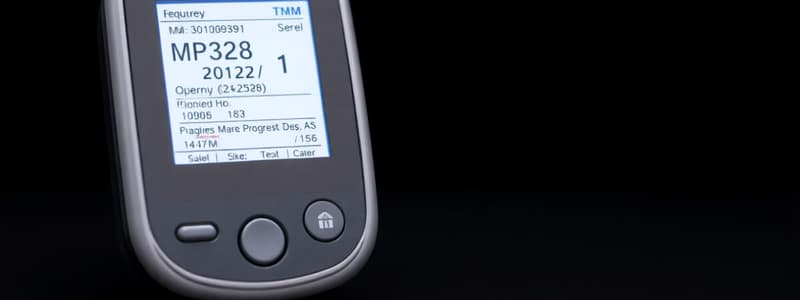Podcast
Questions and Answers
What is a key purpose of a tabular specification in an insulin pump system?
What is a key purpose of a tabular specification in an insulin pump system?
- To outline possible alternative actions based on blood sugar levels (correct)
- To replace the need for medical professionals
- To provide entertainment during medical procedures
- To set the price of the insulin pump
The quality criteria for requirements include the need for completeness and correctness.
The quality criteria for requirements include the need for completeness and correctness.
True (A)
What is the action taken by the insulin pump when the sugar level is stable?
What is the action taken by the insulin pump when the sugar level is stable?
CompDose = 0
Requirements must be ________, meaning they can be verified if implemented correctly.
Requirements must be ________, meaning they can be verified if implemented correctly.
Which of these is NOT one of the quality criteria for requirements?
Which of these is NOT one of the quality criteria for requirements?
A requirement should be ________, meaning it should describe what stakeholders truly need.
A requirement should be ________, meaning it should describe what stakeholders truly need.
Match the following terms with their definitions.
Match the following terms with their definitions.
What is a key characteristic that ensures requirements do not conflict with higher-level requirements?
What is a key characteristic that ensures requirements do not conflict with higher-level requirements?
Requirements validation ensures that requirements are written in a way that they can be objectively verified.
Requirements validation ensures that requirements are written in a way that they can be objectively verified.
What is the cost of fixing a requirements error after delivery compared to fixing an implementation error?
What is the cost of fixing a requirements error after delivery compared to fixing an implementation error?
Requirements must be ________ to ensure they can be linked to their sources and related artifacts.
Requirements must be ________ to ensure they can be linked to their sources and related artifacts.
Match the following requirements validation characteristics with their definitions:
Match the following requirements validation characteristics with their definitions:
Which of the following is NOT a characteristic of requirements validation?
Which of the following is NOT a characteristic of requirements validation?
Maintaining a history of changes made to each requirement is an aspect of modifiability.
Maintaining a history of changes made to each requirement is an aspect of modifiability.
How should system requirements be written to avoid disputes?
How should system requirements be written to avoid disputes?
What is the definition of Software Requirements according to SEVOCAB?
What is the definition of Software Requirements according to SEVOCAB?
Requirements Engineering focuses solely on developing the technical aspects of software.
Requirements Engineering focuses solely on developing the technical aspects of software.
What is a common consequence when IT projects are canceled?
What is a common consequence when IT projects are canceled?
Requirements Engineering is concerned with discovering, eliciting, developing, analyzing, determining ______ methods, validating, communicating, documenting, and managing requirements.
Requirements Engineering is concerned with discovering, eliciting, developing, analyzing, determining ______ methods, validating, communicating, documenting, and managing requirements.
Match the following reasons why Requirements Engineering is not done with their explanations:
Match the following reasons why Requirements Engineering is not done with their explanations:
Which of the following is a part of the Requirements Engineering process?
Which of the following is a part of the Requirements Engineering process?
The Standish Group Chaos Report indicates that proper requirements can significantly reduce project cancellations.
The Standish Group Chaos Report indicates that proper requirements can significantly reduce project cancellations.
Name one common misconception that leads to not conducting Requirements Engineering.
Name one common misconception that leads to not conducting Requirements Engineering.
Which type of requirement provides a structured document detailing the system’s functions and operational constraints?
Which type of requirement provides a structured document detailing the system’s functions and operational constraints?
Non-functional requirements describe what the software does.
Non-functional requirements describe what the software does.
What are the two main types of requirements in software development?
What are the two main types of requirements in software development?
Functional requirements describe the __________ that the software is to execute.
Functional requirements describe the __________ that the software is to execute.
Match the following types of requirements with their descriptions:
Match the following types of requirements with their descriptions:
Development requirements are constraints on the software development process.
Development requirements are constraints on the software development process.
What do non-functional requirements often describe?
What do non-functional requirements often describe?
What do organizational requirements stem from?
What do organizational requirements stem from?
External requirements are irrelevant to the system development process.
External requirements are irrelevant to the system development process.
What is an example of an external requirement in a healthcare system?
What is an example of an external requirement in a healthcare system?
Non-functional requirements may affect the overall __________ of a system rather than individual components.
Non-functional requirements may affect the overall __________ of a system rather than individual components.
Match the following non-functional requirements with their categories:
Match the following non-functional requirements with their categories:
Which of the following is a type of non-functional requirement?
Which of the following is a type of non-functional requirement?
Delivery implementation requirements are considered organizational requirements.
Delivery implementation requirements are considered organizational requirements.
What type of requirements ensure that a system operates within the law?
What type of requirements ensure that a system operates within the law?
What describes the services the system should provide and how it reacts to inputs?
What describes the services the system should provide and how it reacts to inputs?
User requirements are primarily owned by developers.
User requirements are primarily owned by developers.
What type of requirements focus on the timing constraints and development process?
What type of requirements focus on the timing constraints and development process?
The document that outlines detailed descriptions of the system's functions, services, and operational constraints is known as the ______.
The document that outlines detailed descriptions of the system's functions, services, and operational constraints is known as the ______.
Match the types of requirements with their descriptions:
Match the types of requirements with their descriptions:
Which of the following is a characteristic of non-functional requirements?
Which of the following is a characteristic of non-functional requirements?
Functional requirements include constraints on the services offered by the system.
Functional requirements include constraints on the services offered by the system.
Who primarily writes user requirements?
Who primarily writes user requirements?
Flashcards
Tabular Specification
Tabular Specification
A table used to define actions based on different conditions. It's a way to map inputs to outputs in a systematic way.
Insulin Pump Computation
Insulin Pump Computation
The insulin pump calculates insulin needs based on how blood sugar is changing.
Software Requirements Quality Criteria
Software Requirements Quality Criteria
Standards for software requirements, ensuring they are correct, feasible, necessary, prioritized, unambiguous, and verifiable.
Correct Requirement
Correct Requirement
Signup and view all the flashcards
Feasible Requirement
Feasible Requirement
Signup and view all the flashcards
Necessary Requirement
Necessary Requirement
Signup and view all the flashcards
Prioritized Requirement
Prioritized Requirement
Signup and view all the flashcards
Complete Requirements Specification
Complete Requirements Specification
Signup and view all the flashcards
Consistent Requirements
Consistent Requirements
Signup and view all the flashcards
Modifiable Requirements
Modifiable Requirements
Signup and view all the flashcards
Traceable Requirements
Traceable Requirements
Signup and view all the flashcards
Requirements Validation
Requirements Validation
Signup and view all the flashcards
Validity (Requirements)
Validity (Requirements)
Signup and view all the flashcards
Consistency (Requirements)
Consistency (Requirements)
Signup and view all the flashcards
Completeness (Requirements)
Completeness (Requirements)
Signup and view all the flashcards
Realism (Requirements)
Realism (Requirements)
Signup and view all the flashcards
Software Requirements
Software Requirements
Signup and view all the flashcards
Requirements Engineering (RE)
Requirements Engineering (RE)
Signup and view all the flashcards
RE Process Steps
RE Process Steps
Signup and view all the flashcards
RE Importance
RE Importance
Signup and view all the flashcards
Software Project Failures
Software Project Failures
Signup and view all the flashcards
Common RE Obstacles
Common RE Obstacles
Signup and view all the flashcards
Business User Expectations
Business User Expectations
Signup and view all the flashcards
Incomplete Requirements
Incomplete Requirements
Signup and view all the flashcards
Functional Requirements
Functional Requirements
Signup and view all the flashcards
Non-Functional Requirements
Non-Functional Requirements
Signup and view all the flashcards
User Requirements
User Requirements
Signup and view all the flashcards
System Requirements
System Requirements
Signup and view all the flashcards
Development Requirements
Development Requirements
Signup and view all the flashcards
Product Requirements
Product Requirements
Signup and view all the flashcards
Constraint
Constraint
Signup and view all the flashcards
Why are different types of Requirements needed?
Why are different types of Requirements needed?
Signup and view all the flashcards
Importance of Early Requirement Definition
Importance of Early Requirement Definition
Signup and view all the flashcards
What are organizational requirements?
What are organizational requirements?
Signup and view all the flashcards
What are external requirements?
What are external requirements?
Signup and view all the flashcards
Usability requirement
Usability requirement
Signup and view all the flashcards
Reliability requirement
Reliability requirement
Signup and view all the flashcards
Security requirement
Security requirement
Signup and view all the flashcards
Performance requirement
Performance requirement
Signup and view all the flashcards
Impact of non-functional requirements
Impact of non-functional requirements
Signup and view all the flashcards
Study Notes
Identifying Needs & Capturing User Requirements
- This lecture covers requirement elicitation techniques, focusing on methods to understand user needs and translate them into functional requirements for software development.
Requirement Elicitation Techniques
-
Interviews: Formal or informal conversations with stakeholders to gather information about their needs and expectations. Types include closed (pre-determined questions) and open (no predefined agenda). Effective interviews require open-mindedness, active listening, and using prompts (e.g., requirements proposal, working on a prototype) to encourage discussion.
-
Scenarios: Real-life examples describing how users interact with the system, including normal flow, errors, and concurrent activities. Scenarios help illustrate expected behavior and potential issues.
-
Prototypes: Early models or simulations of the system to help stakeholders visualize and understand functionalities.
-
Facilitated Meetings: Meetings with stakeholders to guide them in identifying and defining their requirements.
-
Task Analysis: A top-down breakdown of tasks performed by users and the system. This technique establishes a hierarchy of tasks and determines the knowledge needed for each.
-
User Stories: Brief descriptions of how users interact with the system from their perspective, often used in Agile development.
-
Introspection: The analyst's understanding of what users need based on experience with the domain. This is largely a first step, used as a starting point or when other methods are difficult to employ.
-
Questionnaires: Used to collect information from multiple stakeholders quickly, typically employed early in the process. They may contain open-ended/closed questions to gain broad/focused feedback. Careful question design minimizes irrelevant data.
-
Card Sorting: An elicitation technique involving stakeholders creating and organizing cards with system functionalities and ranking them to reveal priorities.
Scenario for Collecting Medical History in MHC-PMS
- Initial assumption: Patient has been seen by a receptionist and their details entered. A nurse is gathering medical history.
- Normal flow: Searching for patient by surname, first name, and date of birth. Entering consultation details (free text), medical conditions, medication, allergies and home life information to capture patient information details and issues impacting the user experience.
- Issues/Problem: Patient information may not be available in the database. The system must handle this situation and allow creating of new records as necessary.
Task Analysis (Pet Store Example)
- Task analysis breaks down complex tasks into smaller, manageable components.
- The example shows the hierarchy of tasks required for a pet store point-of-sale (POS) system, demonstrating how user and system interactions are documented. This creates a hierarchy of tasks and determines the knowledge required for those tasks.
Introspection
- This technique is used as a starting point in understanding users' needs and system design.
- It works best when the analyst is experienced with the domain.
- It should be used with caution when users are unfamiliar with software.
Card Sorting
- Using cards to identify and rank functionalities, this helps discover priorities; users also identify potential omissions/corrections and ranking helps prioritize features.
Laddering
- This technique involves asking customers short, prompting questions to investigate their use cases and system requirements, often showing how different features interact.
Ethnography
- This observational technique involves studying users in their natural environment to gain insights about how they complete tasks. The goal is to derive requirements for the system based on observations.
Requirement Analysis
- Detect and resolve conflicts between requirements.
- Explore the system's interaction with its environment
- Elaborate system requirements to determine software needs.
- Use different analysis methods to classify requirements
Software Requirements Specification
- Establishes agreements between customers and contractors/suppliers outlining software functionality, expected behavior, and limitations.
- Enables rigorous assessment before design and reduces later design changes.
- Can be used as a basis for verification/validation plans when testing the software.
- Supports the transfer of the software to different user groups/platforms.
Commitment and Prioritization
- The commitment level (must, will, should, would, could) reflects the obligation related to meeting the requirement.
- This is often coupled with an assigned priority level for each functional requirement to reflect relative importance during deployment.
Ways of Writing Requirements Specification
- Natural language: Detailed, numbered sentences in clear language that describe requirements.
- Structured natural language: Using a standard template to organize language around field-based criteria, e.g., Inputs, outputs, description, side-effects.
- Graphical notations: UML use cases and sequence diagrams are common, adding visual representation of functional requirements.
- Mathematical specifications: Formal methods using sets/formal logic to describe functional system properties, less user-friendly but unambiguous.
Types of Specifications (Structured Specifications, Tabular Specification)
- Structured Specifications: Detailed descriptions of functions, inputs, outputs, pre/post conditions and side effects.
- Tabular Specifications: Supplementary to natural language, lists various conditions and associated system responses to identify possible system states and their actions.
Software Requirements Quality
- Criteria like correctness, feasibility, necessity, prioritization, unambiguous statements, and verifiability ensure requirements accurately capture user needs and are technically achievable. Also include completeness (no omissions) and consistency (no contradictory requirements).
Requirements Validation
- Requirements validation is crucial for ensuring the system meets user needs fully, as fixes are exponentially more costly further down the software development lifecycle.
- Techniques used include:
- Reviews: Team analysis for consistency and errors.
- Prototyping: Testing the actual system and gathering real-world user feedback.
- Test-case generation: Ensuring requirements lead to testable software.
Requirements Elicitation (Overview & Process)
- The process of eliciting (understanding and documenting) requirements involves identifying the origin of requirements and how users/stakeholders will be involved with the system.
- Includes analysis of stakeholders, understanding the application domain and related process and rules, documenting sources of requirements and selecting techniques and tools for the project.
- Stakeholders: All parties involved in the system's development and deployment.
- Sources: Individuals/departments with in-depth knowledge of the subject domain.
Types of Requirements
- User Requirements: High-level statements describing the desired outcomes/user experience with the software. This defines what the software should do.
- System Requirements: Formal, detailed specifications defining the software's functionality in detail. This specifies how the software should do what the user wants, including inputs, outputs, and expected workflows.
Functional Requirements
- Describe what the software should do. It could include steps such as 'adding a new account,' or how to access functionalities.
Non-functional Requirements
- Describe the qualities and limitations of the system, including constraints. This could include response time, reliability, or any constraints on how the software should be used.
Metrics for Specifying Non-Functional Requirements
- Measures to quantify non-functional requirements (reliability, performance, etc.) such as processed transactions/second, error rates, and user training times, which help in quantifying the effectiveness of the software.
Studying That Suits You
Use AI to generate personalized quizzes and flashcards to suit your learning preferences.




